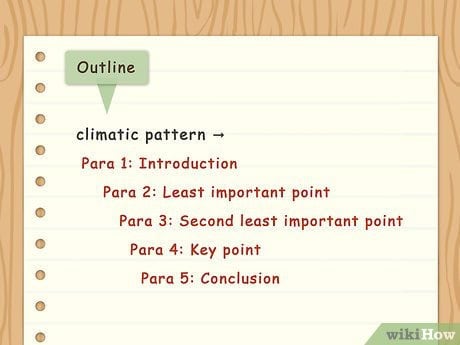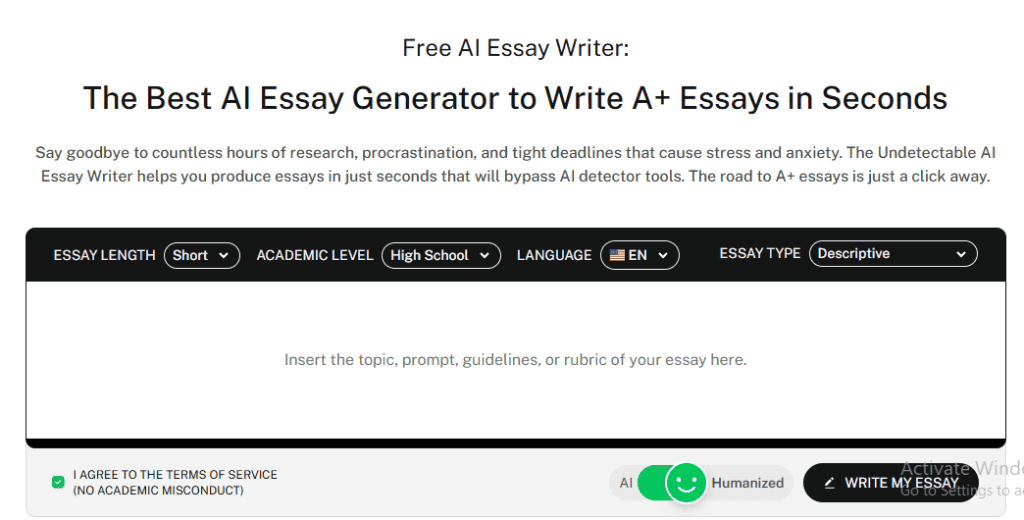The most common type of essay your teachers probably asked you to write in school is the descriptive essay.
It’s one of the simplest forms but also one of the most important if you’re looking to become a stronger writer.
Descriptive essays are the bread and butter of creative writing.
They project vivid imagery and sensory details, pulling your audience through an experience, showcasing your writing’s impact, and offering a glimpse into your imagination.
But writing truly effective descriptive essays isn’t as simple as piling on adjectives.
How do you create a scene that readers can actually see, hear, taste, smell, and touch? What techniques elevate your descriptions from basic to breathtaking?
Famous writers like Joan Didion, David Foster Wallace, and Annie Dillard have mastered the art of description, using keen observation and precise language to make readers feel like they’re right there with them.
If you want to ace your next assignment, develop your creative writing abilities, or simply learn to observe the world more closely, here’s everything you need to craft a compelling descriptive essay.
What Is a Descriptive Essay?
A descriptive essay is a form of creative writing that paints a detailed picture of a person, place, object, experience, or emotion.
Unlike argumentative or expository essays that aim to convince or explain, descriptive essays immerse readers in sensory details.
They don’t just tell readers about something but rather show it through carefully chosen language that appeals to the five senses.


Never Worry About AI Detecting Your Texts Again. Undetectable AI Can Help You:
- Make your AI assisted writing appear human-like.
- Bypass all major AI detection tools with just one click.
- Use AI safely and confidently in school and work.
Think of it this way: if a narrative essay tells a story and an argumentative essay makes a case, a descriptive essay creates an experience.
Your goal is to make readers feel as though they can see the shimmering lake water, hear the leaves rustling, smell the freshly baked bread, taste the tart lemonade, or feel the rough texture of tree bark.
Good descriptive writing transforms the ordinary into the extraordinary.
A skilled writer doesn’t just describe a childhood bedroom but immerses the reader in a vivid sensory tableau, a technique known in rhetorical studies as enargeia: the use of language so rich in detail it creates mental imagery so clear it feels real.
Key Features of a Descriptive Essay
What separates a truly effective descriptive essay from mere description?
Here are the essential elements:
- Sensory details that appeal to sight, sound, smell, taste, and touch
- Vivid language that brings scenes and objects to life
- Figurative language like metaphors, similes, and personification
- Specific focus on a particular subject rather than multiple topics
- Organized structure that guides readers through the description
- Emotional connection that reveals why this subject matters
- Clear purpose behind the description (beyond just describing)
The most powerful descriptive essays organize details meaningfully rather than just cataloging them.
They guide the reader’s attention from one element to another, creating a coherent impression rather than a jumble of random observations.
Common Descriptive Essay Topics
Struggling to find something worth describing?
The truth is, almost anything can become the subject of a descriptive essay if you observe it closely enough.
Here are some popular categories and specific examples:
Places:
- Your childhood home
- A bustling farmer’s market
- An abandoned building
- A scenic viewpoint
- A busy city intersection at rush hour
People:
- A family member who shaped your life
- A stranger whose appearance struck you
- Someone with unique mannerisms or habits
- A person engaged in their profession or passion
- A memorable teacher or mentor
Objects:
- A family heirloom with history
- A handmade item with special significance
- A natural object like a seashell or an unusual stone
- A tool or instrument in action
- A piece of technology, old or new
Experiences:
- Your first day in a new environment
- A memorable celebration or festival
- A challenging physical activity
- A moment of profound realization
- The experience of being caught in extreme weather
Emotions:
- The feeling of homesickness
- The sensation of falling in love
- The weight of grief or loss
- The glow of accomplishment
- The discomfort of embarrassment
The key to selecting a good topic is personal connection. Choose something that evokes strong sensory memories or feelings for you, as your genuine connection to the subject will help you recall specific details and communicate authentic emotions.
How to Structure a Descriptive Essay

Image Source: WikiHow
While descriptive essays allow more creative freedom than other types of essays, they still benefit from clear organization.
A well-structured descriptive essay guides the reader’s imagination in a deliberate way, creating a cohesive impression rather than a haphazard collection of details.
Here’s a typical structure that works for most descriptive essays:
- Introduction:
- Begin with a hook that captures interest
- Introduce your subject briefly
- Include a thesis statement that establishes your overall impression or feeling
- Hint at why this subject is significant to you
- Body Paragraphs:
- Organize by sensory impressions (sight, sound, smell, etc.)
- OR organize by spatial relationship (top to bottom, near to far)
- OR organize by order of importance (least to most striking details)
- Use topic sentences to guide transitions between aspects
- Maintain focus on creating a unified impression
- Conclusion:
- Reflect on the significance of what you’ve described
- Reinforce the dominant feeling or impression
- Possibly connect to broader meaning or personal growth
- Leave readers with a final memorable image or thought
Each paragraph in the body should focus on one aspect of your subject, developing it fully before moving to the next.
This creates a sense of focus and prevents the scattered feeling that can happen when descriptions jump randomly from one detail to another.

Wrapping up a descriptive essay can feel tricky — especially when you’re trying to end on a vivid, emotional note that actually resonates. That’s exactly why we created our AI Conclusion Generator.
It’s designed to help you bring your essay full circle by analyzing what you’ve written and generating a strong, sensory-rich closing paragraph that feels natural and powerful.
Whether you’re describing a peaceful garden or a chaotic city street, our tool can help you craft a conclusion that sticks with your reader — and sounds like you.
How to Write a Descriptive Essay
Writing a vivid, descriptive essay takes preparation and attention to detail.
Here’s a step-by-step process to guide you from blank page to polished essay.
1. Choose Your Subject Carefully
Select something meaningful to you. Your personal connection will help you notice and convey details that might escape someone else.
Think about places, people, or experiences that have left a strong impression on you.
2. Observe and Take Notes
Before writing, spend time carefully observing your subject. If you’re describing a place, visit it if possible.
For an object, examine it from different angles. Take detailed notes about:
- Visual details: Colors, shapes, light, patterns
- Sounds: Volume, pitch, rhythm, source
- Smells: Intensity, associations, pleasantness
- Textures: How things feel to the touch
- Tastes: If relevant to your subject
3. Create a Quick Outline
Organize your observations into a logical structure.
Decide whether you’ll arrange details by:
- Sensory category (visual, auditory, etc.)
- Spatial relation (left to right, inside to outside)
- Chronological order (morning to night, seasons)
- Emotional impact (building toward most powerful)
4. Generate a Draft Using AI Tools
This is where tools like Undetectable AI’s AI Essay Writer can be incredibly helpful.
Here’s how to use it:
- Enter your essay topic in the AI Essay Writer
- Select “Descriptive Essay” from the format options
- Include key details from your observations
- Specify the tone you want (nostalgic, excited, contemplative)
- Click “Generate” to create a first draft
The AI will produce an organized outline and draft that includes your key points while maintaining a natural writing style that won’t be flagged as AI-generated.
5. Enhance Your Draft
Review the generated content and enhance it with:
- More specific personal details only you would know
- Unique figurative language and comparisons
- Your authentic voice and perspective
6. Revise for Sensory Balance
Check that you’ve included a mix of sensory details. Many writers focus heavily on visual descriptions while neglecting other senses.
Make sure readers can hear, smell, and feel your subject, not just see it.
7. Edit for Precision and Impact
Replace generic adjectives with specific, vivid ones. Instead of “beautiful,” describe exactly what makes something beautiful. Instead of “loud,” describe the specific quality of the sound and its effect on you.
8. Polish Your Final Draft
Read your essay aloud to catch awkward phrasing or repetitive sentence structures.
Ensure your descriptions flow naturally and create a cohesive impression rather than a random collection of details.
Pro Tip: Just look at Maya Angelou’s I Know Why the Caged Bird Sings. Her description of childhood trauma isn’t just visual—it’s visceral. She doesn’t tell you what happened. She makes you feel it. That’s the level of immersion a great descriptive essay aims for.

Descriptive Essay Example (Short Sample)
To see descriptive writing at its best, take this excerpt from James Baldwin’s Notes of a Native Son.
Notice how he weaves emotion, observation, and vivid sensory language into a moment of deep personal significance:
“On the 29th of July, in 1943, my father died. On the same day, a few hours later, his last child was born. He had been ill a long time… and he had been, finally, carried to a sanitarium. It had not been easy for my father to reconcile himself to what he called ‘the white man’s world.’ He had spent most of his life in a rage that only his faith kept at bay.”
“It was a dark and damp afternoon. The sky was the color of smoke, the pavements wet and gleaming, and a cold wind whipped around corners. I was walking through Harlem, looking at the faces, at the shadowy storefronts, at the bars and churches that seemed to crouch in the wind. I felt as though I were moving through a city of ghosts.”
“The funeral was held in a small, hot church in Harlem, with flies buzzing, people shifting in their seats. The minister’s voice droned on and on, rising and falling, as if trying to lift us out of the stifling air. My youngest brother cried beside me. I did not cry. I could not cry.”
“The riots began the next day. It started with a rumor—always a rumor—that a white policeman had beaten a Black soldier. Windows shattered like nerves snapping. Fire leapt across rooftops. Sirens howled in every direction. I stood on the sidewalk watching a man hurl a brick through a butcher shop window. Meat spilled onto the pavement.”
“In that moment, I felt something collapse inside me—not sadness exactly, but a clarity. A recognition. My father had tried to warn me. This was the rage he knew. This was the bitterness he carried. And now it belonged to me too.”
Tips for Writing a Powerful Descriptive Essay
Want to transform your descriptive writing from good to unforgettable?
Here are proven techniques that elevate your essay:
- Show, don’t tell: Instead of stating, “The beach was beautiful,” show readers the “translucent turquoise waves curling onto sugar-white sand as pelicans dive through golden afternoon light.”
- Use specific, concrete details: Replace “many flowers” with “clusters of purple coneflowers and black-eyed Susans nodding in the breeze.” Specific details create vivid images.
- Employ all five senses: Don’t just describe how things look. Include the whispered hiss of falling snow, the tang of metal on your tongue during a thunderstorm, or the comforting weight of a cat sleeping on your lap.
- Find fresh comparisons: Use defamiliarization and avoid clichés like “cold as ice.” Create original similes and metaphors: “The library was a catacomb of knowledge, with ideas slumbering in leather-bound tombs, waiting to be resurrected.”
- Vary your sentence structure: Mix short, punchy sentences with longer, flowing ones. Rhythm matters. Short sentences increase tension. Longer, more complex sentences can mirror more complex emotions or panoramic visual scans across a landscape.
- Use precise verbs: Instead of “walking,” your character might “shuffle,” “stride,” “meander,” or “strut.” Strong verbs do double duty, conveying both action and manner.
- Include telling details: The most powerful descriptions often focus on unexpected details—the chipped nail polish on a surgeon’s hand, the mismatched buttons on a professor’s shirt, or the single functioning taillight on an otherwise immaculate luxury car.
- Connect description to emotion: Show how the physical details connect to feelings or memories. The peeling wallpaper might not just be a visual detail but perhaps represent neglect, the passage of time, or childhood memories.
How AI Tools Can Help With Descriptive Essays
Staring at a blank screen, trying to make a lake look magical, or a hallway feel haunted?
Undetectable AI Essay Writing Tools can step in not to write for you but to get you unstuck and writing better and faster.

1. AI Essay Writer: Need a jumpstart? Just enter your topic and tone, and the AI Essay Writer will generate an outline, a mood-setting intro, or full body paragraphs that stay on theme and pass AI detection.
It’s a lot like scaffolding for your scene.

2. AI Paraphrasing tool: Got a sentence like “the room was nice”? Drop it into the AI Paraphraser and watch it morph into “sunlight poured through gauzy curtains, brushing gold across the antique floorboards.”
That’s the glow-up your descriptions deserve.

3. AI Chat: Feeling stuck or uninspired? Ask AI Chat for creative writing prompts, fresh metaphors, or real-time feedback on your descriptions.
Whether you’re building a haunted carnival or a cozy bookstore, it’s like having a writing partner that never runs out of ideas.
Great description is all about precision, sensory detail, and rhythm. These tools help you sharpen all three without sounding robotic.
See our AI Detector and Humanizer in action—just use the widget below!
FAQs About Descriptive Essays
Can I use the first person in a descriptive essay?
Yes, especially when writing about a personal memory or experience.
Using “I” can help immerse readers in your point of view and add emotional depth.
How long should a descriptive essay be?
Most range between 500 and 1000 words, depending on the assignment.
The key is to include enough vivid detail without overwhelming or rambling.
Should I use dialogue in a descriptive essay?
You can, but keep it minimal and intentional.
A few lines of dialogue can add realism or reveal character, but the focus should stay on description.
See It, Say It, Make Them Feel It
The descriptive essay is one of writing’s purest forms—a direct channel between what you perceive and what your reader experiences.
Through careful observation and thoughtful language choices, you can create descriptions that don’t just inform readers about a subject but transport them there, engaging their senses and emotions.
The best descriptive essays reveal the extraordinary within the ordinary.
They make readers notice details they might otherwise overlook and help them see familiar subjects in new ways.
This type of writing doesn’t just communicate information but transforms perceptions.
As you develop your descriptive writing skills, having the right tools makes all the difference.
Use the AI Essay Writer to generate outlines or full drafts, the AI Paraphraser to sharpen your imagery, and AI Chat to brainstorm metaphors, settings, or prompts, all available at Undetectable AI.
Good writing takes time, but smart tools help you spend that time where it matters most: on your ideas.
Start crafting essays that feel as real as the world you’re describing.
